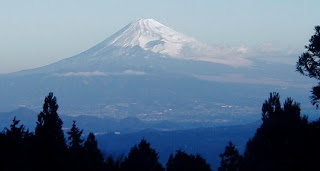I have only previously seen Japan in summer, travelling on a rail pass, and Fuji-san was always clouded over at the summit.
Today, from the fifteenth floor of the Tokyo hotel I have just left as well as from the right-hand window of the near-empty skinkansen bound for Shizuoka, the view of Japan's highest mountain, a volcano, is clear and impressive.
Shizuoka Prefecture is the heartland of Japanese football, having the schools and two teams (one the dynamic-sounding Shimizu S-Pulse) from which many of the national side's players have emerged. It's nonetheless unlikely to hold a place in the heart of the average Englishman, if known at all. It was here that Brazil eliminated England from the 2002 World Cup, a game memorable for Ronaldhino's lob over a stranded 'safe hands' David Seaman, a match I watched miserably from a Croatian hotel room.
The city itself is better known for tremors of a more serious kind, and these ones wouldn't reach England. Disastrous earthquakes strike here every 100-150 years, the last 'Tokai' quake having taken place - somewhat worryingly if you do the maths - in 1854, and today Shizuoka is considered the city most vulnerable to catastrophic earthquake in the whole of Japan. At least this means its people are prepared and buildings tested, unlike those of Kobe in 1995.
At Snow's house, there is an earthquake emergency pack with water and tents and long-life foods, kept just inside the front door. Once detected, earthquake early warning signs automatically send alarms to mobile phones, with the possible 10-20 second advance warning unlikely to allow you time to do more than climb under the nearest table or switch off the gas. There are evacuation centres in every neighbourhood, and Shizuoka's earthquake education centre unintentionally makes for a worthwhile tourist outing, with simulators as well as mock-up post-shock rooms contrasting the impact where furniture and dangerous or fragile items have been strapped and fastened to walls with those where they have not.
Shizuoka did have a relatively serious earthquake last summer - measuring 6.5 - 6.7. It caused damage to parts of the city as well as the Izu Peninsula where I had been a few days earlier. Within seconds, national TV was showing video footage from mounted cameras of shaking offices and streets.
In Snow's house, there were a few cracks and smashed photo displays. It's easy to see why pictures and paintings hung on walls are rare in Japan, yet I'm not sure you'd want them in homes as elegantly spartan as this anyway.
On the evening of 3rd January, we ate maki-sushi rolls filled self-service style from a rotating seafood dish, just as we'd done the previous summer.
Then, the following morning, Snow's mum served the traditional New Year's Day breakfast, including a special soup with mochi rice balls, a range of boiled vegetables, some unrecognisable, as well as sweets made from chestnuts picked locally by her dad. I think this was my New Year's Day.
We went to the temple for the bowing, clapping and bell-ringing and watched the local businessman and male staff from the prefectural office troop along to do the same on this, the first full working day of the year. I always feel really at home here, and it improves my limited Japanese; in fact, it reminds me of French and German exchanges, always asking 'how do you say...?'.
Shame to be moving on so soon ...
.jpg)


.jpg)
.jpg)

.jpg)
.jpg)



No comments:
Post a Comment